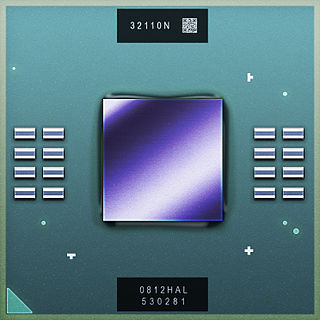
The Z80 CPU is an 8-bit based microprocessor. It was introduced by Zilog in 1976 as the startup company's first product. The Z80 was conceived by Federico Faggin in late 1974 and developed by him and his then-11 employees at Zilog from early 1975 until March 1976, when the first fully working samples were delivered. With the revenue from the Z80, the company built its own chip factories and grew to over a thousand employees over the following two years.

An embedded system is a controller programmed and controlled by a real-time operating system (RTOS) with a dedicated function within a larger mechanical or electrical system, often with real-time computing constraints. It is embedded as part of a complete device often including hardware and mechanical parts. Embedded systems control many devices in common use today. Ninety-eight percent of all microprocessors manufactured are used in embedded systems.

The KiddiComp concept, envisioned by Alan Kay in 1968 while a PhD candidate, and later developed and described as the Dynabook in his 1972 proposal "A personal computer for children of all ages", outlines the requirements for a conceptual portable educational device that would offer similar functionality to that now supplied via a laptop computer or a tablet or slate computer with the exception of the requirement for any Dynabook device offering near eternal battery life. Adults could also use a Dynabook, but the target audience was children.

SmartMedia is a flash memory card standard owned by Toshiba, with capacities ranging from 2 MB to 128 MB. SmartMedia memory cards are no longer manufactured.
The Gigabeat was a line of digital media players by Toshiba.

The Qosmio series was Toshiba's consumer-marketed line of high performance desktop replacement laptops. The laptop was first released on July 25, 2004 as the E15-AV101 with a 1.7 GHz Intel Pentium M CPU, 512 megabytes of DDR SDRAM, and a 15-inch XGA 1,024 by 768 screen. Toshiba's most powerful laptop has undergone many revisions, with focus shifting from high-end multimedia functionality to heavy gaming. The current line, the X70 series, was released in 2013, featuring an Intel Core i7 processor with up to 32 gigabytes of DDR3 SDRAM and an nVidia Geforce GTX 770M as well as a 17.3 inch Full HD display.

The Compaq Presario 1200 Series was a line of notebook computers produced between 1998 and 2000 by Compaq. They were originally noted for their AMD processors, light weight and 12-inch LCD screens, while later models included a shift to Intel processors and other changed features. The label of "Compaq Presario 1200" includes a vast set of model numbers and revisions, many of which are not totally compatible, even though the machines share the same general Presario model number.
SONOS, short for "silicon–oxide–nitride–oxide–silicon", more precisely, "polycrystalline silicon"—"silicon dioxide"—"silicon nitride"—"siicon dioxide"—"silicon", is a cross sectional structure of MOSFET, realized in late 70's. This structure is often used for non-volatile memories, such as EEPROM and flash memories. It is sometimes used for TFT LCD displays. It is one of CTF (charge trap flash) variants. It is distinguished from traditional non-volatile memory structures by the use of silicon nitride (Si3N4 or Si9N10) instead of "polysilicon-based FG (floating-gate)" for the charge storage material. A further variant is "SHINOS" ("silicon"—"hi-k"—"nitride"—"oxide"—"silicon"), which is substituted top oxide layer with high-κ material. Another advanced variant is "MONOS" ("metal–oxide–nitride–oxide–silicon"). Companies offering SONOS-based products include Cypress Semiconductor, Macronix, Toshiba, United Microelectronics Corporation and Floadia.
The Sony Toshiba IBM Center of Competence for the Cell Processor is the first Center of Competence dedicated to the promotion and development of Sony Toshiba IBM's Cell microprocessor, an eight-core multiprocessor designed using principles of parallelism and memory latency. The center is part of the Georgia Institute of Technology's College of Computing and is headed by David A. Bader.

HD DVD is a discontinued high-density optical disc format for storing data and playback of high-definition video. Supported principally by Toshiba, HD DVD was envisioned to be the successor to the standard DVD format.

SpursEngine is a microprocessor from Toshiba built as a media oriented coprocessor, designed for 3D- and video processing in consumer electronics such as set-top boxes and computers. The SpursEngine processor is also known as the Quad Core HD processor. Announced 20 September 2007.
Sord Computer Corporation was a Japanese electronics company, founded in 1970 by the entrepreneur Takayoshi Shiina. It is now Toshiba Personal Computer System Corporation, a subsidiary of Toshiba.
The R2000 is a 32-bit microprocessor chip set developed by MIPS Computer Systems that implemented the MIPS I instruction set architecture (ISA). Introduced in January 1986, it was the first commercial implementation of the MIPS architecture and the first commercial RISC processor available to all companies. The R2000 competed with Digital Equipment Corporation (DEC) VAX minicomputers and with Motorola 68000 and Intel Corporation 80386 microprocessors. R2000 users included Ardent Computer, DEC, Silicon Graphics, Northern Telecom and MIPS's own Unix workstations.

Rockchip is a Chinese fabless semiconductor company based in Fuzhou, Fujian province. Rockchip has been providing SoC solutions for tablets & PCs, streaming media TV boxes, AI audio & vision, IoT hardware since founded in 2001. It has offices in Shanghai, Beijing, Shenzhen, Hangzhou and Hong Kong. It designs system on a chip (SoC) products, using the ARM architecture licensed from ARM Holdings for the majority of its projects.
Yahoo! Smart TV is a Smart TV platform developed by Yahoo! based upon the Yahoo! Desktop Widgets platform. Yahoo! Connected TV announced on August 20, 2008 at the Intel Developer Forum in San Francisco as the Widget Channel, it integrates the Yahoo! Widgets Engine with a new television oriented user interface to enable Internet connected applications to run and display on a 10-foot user interface

Toshiba AC100 is a smartbook device from Toshiba.
ARC embedded processors are a family of 32-bit central processing units (CPUs) originally designed by ARC International.










